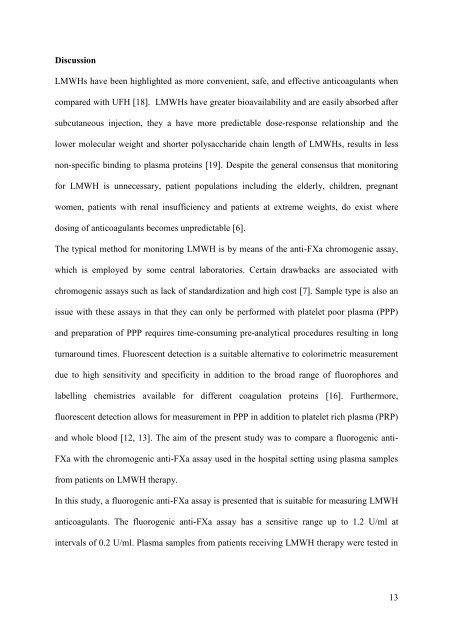(2011) Comparison of a fluorogenic anti-FXa assay with
(2011) Comparison of a fluorogenic anti-FXa assay with
(2011) Comparison of a fluorogenic anti-FXa assay with
Create successful ePaper yourself
Turn your PDF publications into a flip-book with our unique Google optimized e-Paper software.
Discussion<br />
LMWHs have been highlighted as more convenient, safe, and effective <strong>anti</strong>coagulants when<br />
compared <strong>with</strong> UFH [18]. LMWHs have greater bioavailability and are easily absorbed after<br />
subcutaneous injection, they a have more predictable dose-response relationship and the<br />
lower molecular weight and shorter polysaccharide chain length <strong>of</strong> LMWHs, results in less<br />
non-specific binding to plasma proteins [19]. Despite the general consensus that monitoring<br />
for LMWH is unnecessary, patient populations including the elderly, children, pregnant<br />
women, patients <strong>with</strong> renal insufficiency and patients at extreme weights, do exist where<br />
dosing <strong>of</strong> <strong>anti</strong>coagulants becomes unpredictable [6].<br />
The typical method for monitoring LMWH is by means <strong>of</strong> the <strong>anti</strong>-<strong>FXa</strong> chromogenic <strong>assay</strong>,<br />
which is employed by some central laboratories. Certain drawbacks are associated <strong>with</strong><br />
chromogenic <strong>assay</strong>s such as lack <strong>of</strong> standardization and high cost [7]. Sample type is also an<br />
issue <strong>with</strong> these <strong>assay</strong>s in that they can only be performed <strong>with</strong> platelet poor plasma (PPP)<br />
and preparation <strong>of</strong> PPP requires time-consuming pre-analytical procedures resulting in long<br />
turnaround times. Fluorescent detection is a suitable alternative to colorimetric measurement<br />
due to high sensitivity and specificity in addition to the broad range <strong>of</strong> fluorophores and<br />
labelling chemistries available for different coagulation proteins [16]. Furthermore,<br />
fluorescent detection allows for measurement in PPP in addition to platelet rich plasma (PRP)<br />
and whole blood [12, 13]. The aim <strong>of</strong> the present study was to compare a <strong>fluorogenic</strong> <strong>anti</strong>-<br />
<strong>FXa</strong> <strong>with</strong> the chromogenic <strong>anti</strong>-<strong>FXa</strong> <strong>assay</strong> used in the hospital setting using plasma samples<br />
from patients on LMWH therapy.<br />
In this study, a <strong>fluorogenic</strong> <strong>anti</strong>-<strong>FXa</strong> <strong>assay</strong> is presented that is suitable for measuring LMWH<br />
<strong>anti</strong>coagulants. The <strong>fluorogenic</strong> <strong>anti</strong>-<strong>FXa</strong> <strong>assay</strong> has a sensitive range up to 1.2 U/ml at<br />
intervals <strong>of</strong> 0.2 U/ml. Plasma samples from patients receiving LMWH therapy were tested in<br />
13

















